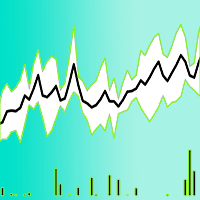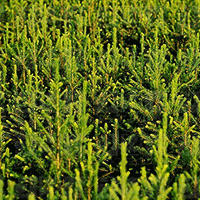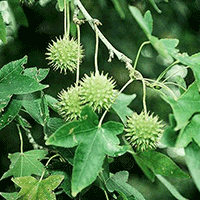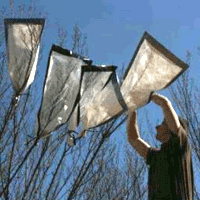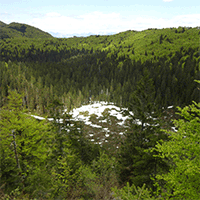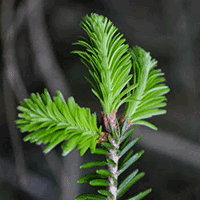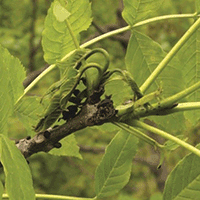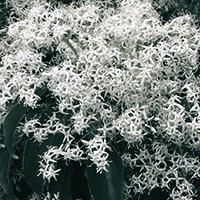Coupling growth with periods of favourable weather conditions minimizes risks of frost damage and maximizes annual height increment. The phenology of the formation of height increment is therefore a trait related to the adaptability of trees to annual weather fluctuations. Strong genetic control of the timing of the onset and cessation of shoot elongation has been reported for Norway spruce, but little is known about its fluctuations that occur during the growth period. The strength of the genetic control of the height growth rate was assessed for young (6 years old) Norway spruce progenies originating from six open-pollinated stands from two local provenance regions. In 2010, the length of the growing period for the studied trees was ca. 60 days. Trees from the more continental provenance region, which had later onset and cessation of height growth (by ca. 2.5 days), exhibited slightly lower increments (by ca. 1%). Accordingly, the provenance region had a significant effect on height growth at the beginning and end of the growing period. Nevertheless, considerable genetic control of the growth rate was found throughout the entire growing period (particularly at the beginning and cessation, ha2 ≥ 0.20), except for a week-long interval around mid-summer (ha2 = 0.07). Similarly, the coefficient of additive genetic variation suggested that breeding could be applied for the improvement of height growth intensity throughout the season. The phenotypic correlations between weekly growth rates and tree height (before growth) were mostly non-significant, suggesting varying mechanisms of control, hence possibility for simultaneous improvement of the traits by breeding.
Keywords
, , , ,
Citation
Matisons R, Zeltinš P, Danusevičius D, Džerina B, Desaine I, Jansons A (2019). Genetic control of intra-annual height growth in 6-year-old Norway spruce progenies in Latvia. iForest 12: 214-219. - doi: 10.3832/ifor2777-012
Academic Editor
Andrea Piotti
Paper history
Received: Mar 06, 2018
Accepted: Feb 06, 2019
First online: Apr 25, 2019
Publication Date: Apr 30, 2019
Publication Time: 2.60 months
© SISEF - The Italian Society of Silviculture and Forest Ecology 2019
Open Access
This article is distributed under the terms of the Creative Commons Attribution-Non Commercial 4.0 International (https://creativecommons.org/licenses/by-nc/4.0/), which permits unrestricted use, distribution, and reproduction in any medium, provided you give appropriate credit to the original author(s) and the source, provide a link to the Creative Commons license, and indicate if changes were made.

Breakdown by View Type
(Waiting for server response...)
Article Usage
Total Article Views: 44352
(from publication date up to now)
Breakdown by View Type
HTML Page Views: 36725
Abstract Page Views: 2930
PDF Downloads: 3837
Citation/Reference Downloads: 1
XML Downloads: 859
Web Metrics
Days since publication: 2424
Overall contacts: 44352
Avg. contacts per week: 128.08
Article Citations
Article citations are based on data periodically collected from the Clarivate Web of Science web site
(last update: Mar 2025)
Total number of cites (since 2019): 2
Average cites per year: 0.29
Publication Metrics
by Dimensions ©
Articles citing this article
List of the papers citing this article based on CrossRef Cited-by.
(1)
Aronsson A (1975)Influence of photo- and thermoperiod on initial stages of frost hardening and dehardening of phytotron-grown seedlings of Scots pine (
Pinus sylvestris L.) and Norway spruce (
Picea abies (L.) Karst.). Studia Forestalia Suecica 128: 1-20.
Online |
Gscholar
(2)
Avotniece Z, Klavinš M, Rodinovs V (2012)Changes of extreme climate events in Latvia. Environmental and Climate Technologies 9: 4-12.
Online |
Gscholar
(3)
Axelsson E, Axelsson B (1986)Changes in carbon allocation patterns in spruce and pine trees following irrigation and fertilization. Tree Physiology 2: 189-204.
CrossRef |
Gscholar
(4)
Beck EH, Heim R, Hansen J (2004)Plant resistance to cold stress: mechanisms and environmental signals triggering frost hardening and dehardening. Journal of Bioscience 29: 449-459.
CrossRef |
Gscholar
(5)
Bolte A, Ammer C, Löf M, Madsen P, Nabuurs GJ, Schall P, Spathelf P, Rock J (2009)Adaptive forest management in central Europe: climate change impacts, strategies and integrative concept. Scandinavian Journal of Forest Research 24: 473-482.
CrossRef |
Gscholar
(6)
Cannell MGR, Johnstone RCB (1978)Free or lammas growth and progeny performance in
Picea sitchensis. Silvae Genetica 27: 248-255.
Online |
Gscholar
(7)
Chmura DJ (2006)Phenology differs among Norway spruce populations in relation to local variation in altitude of maternal stands in the Beskidy Mountains. New Forests 32: 21-31.
CrossRef |
Gscholar
(8)
Cook ER (1985)A time series approach to tree-ring standardization. Dissertation, University of Arizona, Tucson, Arizona, USA, pp. 180.
Gscholar
(9)
Danusevičius D, Persson B (1998)Phenology of natural Swedish populations of
Picea abies as compared with introduced seed sources. Forest Genetics 5: 211-220.
Gscholar
(10)
Danusevičius D, Jonsson A, Eriksson G (1999)Variation among open-pollinated families of
Picea abies (L.) Karst. in response to simulated frost desiccation. Silvae Genetica 48: 158-167.
Online |
Gscholar
(11)
Danusevičius D, Gabrilavičius R (2001)Variation in juvenile growth rhythm among
Picea abies provenances from the Baltic States and adjacent regions. Scandinavian Journal of Forest Research 16: 305-317.
CrossRef |
Gscholar
(12)
Dickerson GE (1969)Techniques for research in quantitative animal genetics. In: “Techniques and Procedures in Animal Science Research”. American Society of Animal Science, Albany, NY, USA, pp. 36-79.
Gscholar
(13)
Dietrichson J (1969)The geographic variation in spring-frost resistance and growth cessation in Norway spruce (
Picea abies (L.) Karst.). Norske Skogforsøksvesen 27: 91-104.
Gscholar
(14)
Dormling I (1973)Photoperiodic control of growth and growth cessation in Norway spruce seedlings. In: Proceedings of IUFRO meeting “Dormancy in Trees”. Kórnik (Poland) 5-9 Sept 1973. Polish Academy of Sciences, Warsaw, Poland, pp. 1-16.
Gscholar
(15)
Dormling I (1993)Bud dormancy, frost hardiness and frost drought in seedlings of Pinus sylvestris and Picea abies. In: “Advances in cold hardiness” (Li PH, Christersson L eds.), CRC Press, Ontario, Canada, pp. 285-298.
Online |
Gscholar
(16)
Ekberg I, Eriksson G, Weng Y (1985)Between- and within-population variation in growth rhythm and plant height in four
Picea abies populations. Studia Forestalia Suecica 167: 1-14.
Online |
Gscholar
(17)
Falconer DS, Mackay TFC (1996)Introduction to quantitative genetics (4
th edn). Longman Group Ltd., London, UK, pp. 465.
Gscholar
(18)
Gailis A (1993)Norway spruce provenances in Latvia. In: Proceedings of IUFRO (S2.2-11) Symposium on “Norway Spruce Provenances and Breeding”. Salaspils (Latvia) 14-18 Sept 1993. State Forest Research Institute “Silava”, Salaspils, Latvia, pp 44-50.
Gscholar
(19)
Gu L, Hanson PJ, Post WM, Kaiser DP, Yang B, Enami R, Pallardy SG, Meyers T (2008)The 2007 Eastern US spring freeze: increased cold damage in a warming world? BioScience 58: 253-262.
CrossRef |
Gscholar
(20)
Hannerz M (1993)Norway spruce provenances in central Sweden height growth and damage in a 12-year-old provenance trial in southern Gästrikland. Reports of the Forest Research Institute of Sweden 1: 1-23. [in Swedish with English summary]
Online |
Gscholar
(21)
Hannerz M (1998)Genetic and seasonal variation in hardiness and growth rhythm in boreal and temperate conifers - a review and annotated bibliography. Reports of the Forest Research Institute of Sweden 2: 1-140.
Gscholar
(22)
Hannerz M (1999)Evaluation of temperature models for predicting bud burst in Norway spruce. Canadian Journal of Forest Research 29: 9-19.
CrossRef |
Gscholar
(23)
Hannerz M, Sonesson J, Ekberg I (1999)Genetic correlations between growth and growth rhythm observed in a short-term test and performance in long-term field trials of Norway spruce. Canadian Journal of Forest Research 29: 768-778.
CrossRef |
Gscholar
(24)
Harris I, Jones PD, Osborn TJ, Lister DH (2014)Updated high-resolution grids of monthly climatic observations the CRU TS3.10 Dataset. International Journal of Climatology 34: 623-642.
CrossRef |
Gscholar
(25)
Heide OM (1974)Growth and dormancy in Norway spruce ecotypes (
Picea abies). I. Interaction of photoperiod and temperature. Physiologia Plantarum 30: 1-12.
CrossRef |
Gscholar
(26)
Kohmann K, Johnsen O (2007)Effects of early long-night treatment on diameter and height growth, second flush and frost tolerance in two-year-old
Picea abies container seedlings. Scandinavian Journal of Forest Research 22: 375-383.
CrossRef |
Gscholar
(27)
Kolari P, Lappalainen H, Hänninen H, Hari P (2007)Relationship between temperature and the seasonal course of photosynthesis in Scots pine at northern timberline and in southern boreal zone. Tellus 59: 542-552.
CrossRef |
Gscholar
(28)
Kroon J, Ericsson T, Jansson G, Andersson B (2011)Patterns of genetic parameters for height in field genetic tests of
Picea abies and
Pinus sylvestris in Sweden. Tree Genetics and Genomes 7: 1099-1111.
CrossRef |
Gscholar
(29)
Langvall O, Löfvenius MO (2002)Effect of shelterwood density on nocturnal near-ground temperature, frost injury risk and budburst date of Norway spruce. Forest Ecology and Management 168: 149-161.
CrossRef |
Gscholar
(30)
Lindner M (2000)Developing adaptive forest management strategies to cope with climate change. Tree Physiology 20: 299-307.
CrossRef |
Gscholar
(31)
Lindner M, Maroschek M, Netherer S, Kremer A, Barbati A, Garcia-Gonzalo J, Seidl R, Delzon S, Corona P, Kolström M, Lexer MJ, Marchetti M (2010)Climate change impacts, adaptive capacity, and vulnerability of European forest ecosystems. Forest Ecology and Management 259 (4): 698-709.
CrossRef |
Gscholar
(32)
Menzel A, Fabian P (1999)Growing season extended in Europe. Nature 397: 659-659.
CrossRef |
Gscholar
(33)
Millar CI, Stephenson NL, Stephens SL (2007)Climate change and forests of the future: managing in the face of uncertainty. Ecological Applications 17: 2145-2151.
CrossRef |
Gscholar
(34)
Muffler L, Beierkuhnlein C, Aas G, Jentsch A, Schweiger AH, Zohner C, Kreyling J (2016)Distribution ranges and spring phenology explain late frost sensitivity in 170 woody plants from the Northern Hemisphere. Global Ecology and Biogeography 25 (9): 1061-1071.
CrossRef |
Gscholar
(35)
Namkoong G, Kang HC, Brouard JS (2012)Tree breeding: principles and strategies. Monographs on Theoretical and Applied Genetics 11, Springer Verlag, New York, USA, pp. 180.
Online |
Gscholar
(36)
Neimane U, Zadina M, Sisenis L, Dzerina B, Pobiarzens A (2015)Influence of lammas shoots on productivity of Norway spruce in Latvia. Agronomy Research 13: 354-360.
Online |
Gscholar
(37)
Odin H (1972)Studies of increment rhythm of Scots pine and Norway spruce. Studia Forestalia Suecica 97: 1-32.
Gscholar
(38)
Owens JN, Molder M (1984)The reproductive cycle of interior spruce. Ministry of Forests, British Columbia, Canada, pp. 29.
Gscholar
(39)
Pallardy SG (2008)Physiology of woody plants (3
rd edn). Elsevier, London, UK, pp. 464.
Gscholar
(40)
Partanen J, Koski V, Hänninen H (1998)Effects of photoperiod and temperature on the timing of bud burst in Norway spruce (
Picea abies). Tree Physiology 18: 811-816.
CrossRef |
Gscholar
(41)
Polle A, Kröniger W, Rennenberg H (1996)Seasonal fluctuations of ascorbate-related enzymes: acute and delayed effects of late frost in spring on antioxidative systems in needles of Norway spruce (
Picea abies L.). Plant and Cell Physiology 37: 717-725.
CrossRef |
Gscholar
(42)
Rone V (1984)Pirmie eglu provenienču vertešanas rezultati Latvija [First results from Norway spruce provenance trials in Latvia]. Jaunakais Mežsaimnieciba 26: 33-38. [in Latvian with English abstract]
Gscholar
(43)
Sarvas R (1973)Annual development cycle of forest trees. In: Proceedings of IUFRO meeting “Dormancy in Trees”. Kórnik (Poland) 5-9 Sept 1973. Polish Academy of Sciences, Warsaw, Poland, pp. 122-131.
Gscholar
(44)
SAS Institute Inc. (2004)SAS/ETS 9.1 User’s guide. SAS Institute Inc., Cary, NC, USA.
Gscholar
(45)
Skrøppa T (1982)Genetic variation in growth rhythm characteristics within and between natural populations of Norway spruce. A preliminary report. Silva Fennica 16: 160-167.
Gscholar
(46)
Slaney M, Wallin G, Medhurst J, Linder S (2007)Impact of elevated carbon dioxide concentration and temperature on bud burst and shoot growth of boreal Norway spruce. Tree Physiology 27: 301-312.
CrossRef |
Gscholar
(47)
Wilmking M, Juday GP, Barber VA, Zald HJ (2004)Recent climate warming forces contrasting growth responses of white spruce at treeline in Alaska through temperature thresholds. Global Change Biology 10: 1724-1736.
CrossRef |
Gscholar
(48)
Zeps M, Jansons A, Matisons R, Stenvall N, Pulkkinen P (2017)Growth and cold hardening of European aspen seedlings in response to an altered temperature and soil moisture regime. Agricultural and Forest Meteorology 242: 47-54.
CrossRef |
Gscholar
(49)
Zuur AF, Ieno EN, Walker NJ, Saveliev AA, Smith GM (2009)Mixed effects models and extensions in ecology with R. Springer, New York, USA, pp. 574.
Online |
Gscholar
